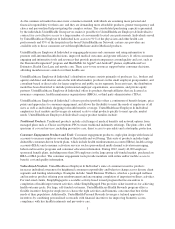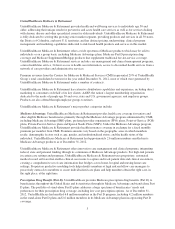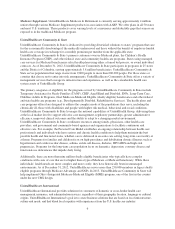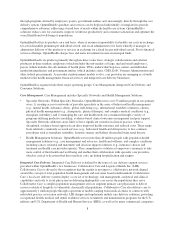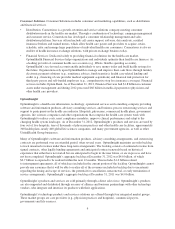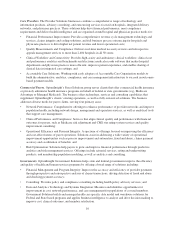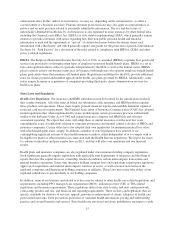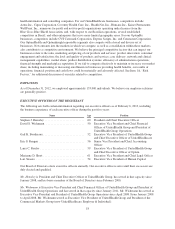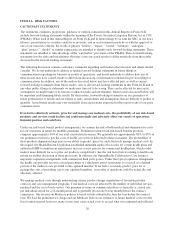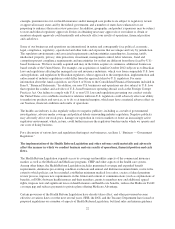United Healthcare 2012 Annual Report Download - page 14
Download and view the complete annual report
Please find page 14 of the 2012 United Healthcare annual report below. You can navigate through the pages in the report by either clicking on the pages listed below, or by using the keyword search tool below to find specific information within the annual report.
upheld in a U.S. Supreme Court decision in the second quarter of 2012. The Health Reform Legislation, portions
of which are summarized below, alters the regulatory environment in which we operate, in some cases to a
significant degree. U.S. federal and state governments continue to enact and consider various legislative and
regulatory proposals that could materially impact certain aspects of the health care system. New laws, regulations
and rules, or changes in the interpretation of existing laws, regulations and rules, as well as a result of changes in
the political climate, could adversely affect our business.
In the event we fail to comply with, or we fail to respond quickly and appropriately to changes in, applicable
laws, regulations and rules, our business, results of operations, financial position and cash flows could be
materially and adversely affected. See Item 1A, “Risk Factors” for a discussion of the risks related to compliance
with federal, state and international laws and regulations.
Health Care Reforms
The Health Reform Legislation expands access to coverage and modifies aspects of the commercial insurance
market, as well as the Medicaid and Medicare programs, CHIP and other aspects of the health care system.
Certain provisions of the Health Reform Legislation have already taken effect and other provisions become
effective at various dates over the next several years. The U.S. Department of Labor (DOL), HHS and the U.S.
Treasury Department have issued or proposed regulations on a number of aspects of Health Reform Legislation,
but final rules and interim guidance on other key aspects of the legislation remain pending.
The following outlines certain provisions of the Health Reform Legislation that are currently effective, currently
effective with phased implementation or are expected to take effect in the coming years.
•Currently Effective: The Health Reform Legislation mandated the expansion of dependant coverage to
include adult children until age 26; eliminated certain annual and lifetime caps on the dollar value of certain
essential health benefits; eliminated pre-existing condition limits for enrollees under age 19; prohibited
certain policy rescissions; prohibited plans and issuers from charging higher cost sharing (copayments or
coinsurance) for emergency services that are obtained outside of a plan’s network; and included a
requirement to provide coverage for preventive services without cost to members (for non-grandfathered
plans).
Commercial fully insured health plans in the large employer group, small employer group and individual
markets with medical loss ratios below certain targets (85% for large employer groups, 80% for small
employer groups and 80% for individuals, as calculated under the definitions in the Health Reform
Legislation and regulations, subject to state specific exceptions) are required to rebate ratable portions of
their premiums to their customers annually.
The Health Reform Legislation also mandated certain changes to coverage determination and appeals
processes, including: expanding the definition of “adverse benefit determination” to include rescissions;
extending external review rights of adverse benefit determinations to insured and self-funded plans; and
improving the clarity of and expanding the types of information in adverse benefit determination notices.
•Currently Effective with Phased Implementation: The Health Reform Legislation also mandated consumer
discounts on brand name and generic prescription drugs for Part D plan participants in the coverage gap.
These consumer discounts will gradually increase over the next several years, which will decrease consumer
out-of-pocket drug spending within the coverage gap, shifting a portion of these costs to the plan sponsor. In
2012, the discount on brand name prescription drugs was 50% while the discount on generic prescription
drugs was 14%.
In addition, as required under the Health Reform Legislation, HHS established a federal premium rate
review process, which generally applies to proposed rate increases equal to or exceeding 10%. The
regulations further require commercial health plans to provide to the states and HHS extensive information
supporting any rate increases subject to the new federal rate review process. The regulations clarify that
HHS review will not supersede existing state review and approval processes, but plans deemed to have a
12



